Business Law Assignment: Negligence, Misrepresentation, and Torts
VerifiedAdded on 2020/04/01
|8
|2691
|116
Report
AI Summary
This report provides a comprehensive overview of business law, with a specific focus on negligence and misrepresentation. It begins by defining negligence as the failure to exercise a duty of care, leading to injury, and misrepresentation as knowingly providing false information to induce a contract. The report delves into the elements required to establish both, referencing relevant legislation like the Civil Liability Act 2002 (NSW). It explores the importance of safety guidelines to avoid lawsuits, providing examples of negligence and misrepresentation in business contexts, including false advertising and misleading advice. The report also discusses defenses against negligence claims, such as comparative and contributory negligence, and risk presumption. Several recent cases are presented to illustrate how courts have addressed negligence and misrepresentation in various scenarios. The report also extends its scope to statutory and public officers, as well as other business torts, including disparagement, wrongful interference, restraint of trade, unfair competition, and computer-related torts. It concludes by highlighting the significance of tort law in holding businesses accountable and providing remedies for those harmed by their actions.
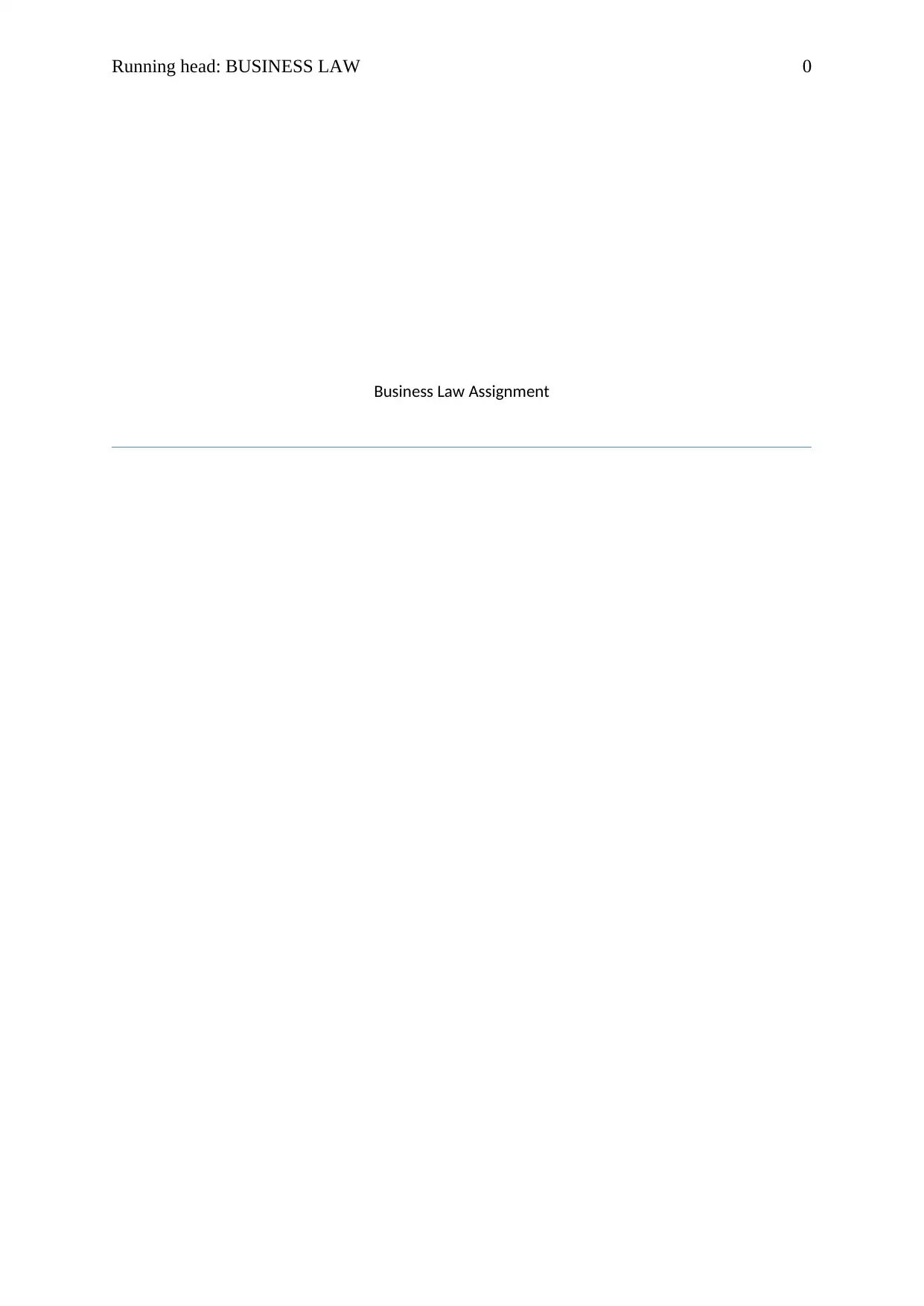
Running head: BUSINESS LAW 0
Business Law Assignment
Business Law Assignment
Paraphrase This Document
Need a fresh take? Get an instant paraphrase of this document with our AI Paraphraser
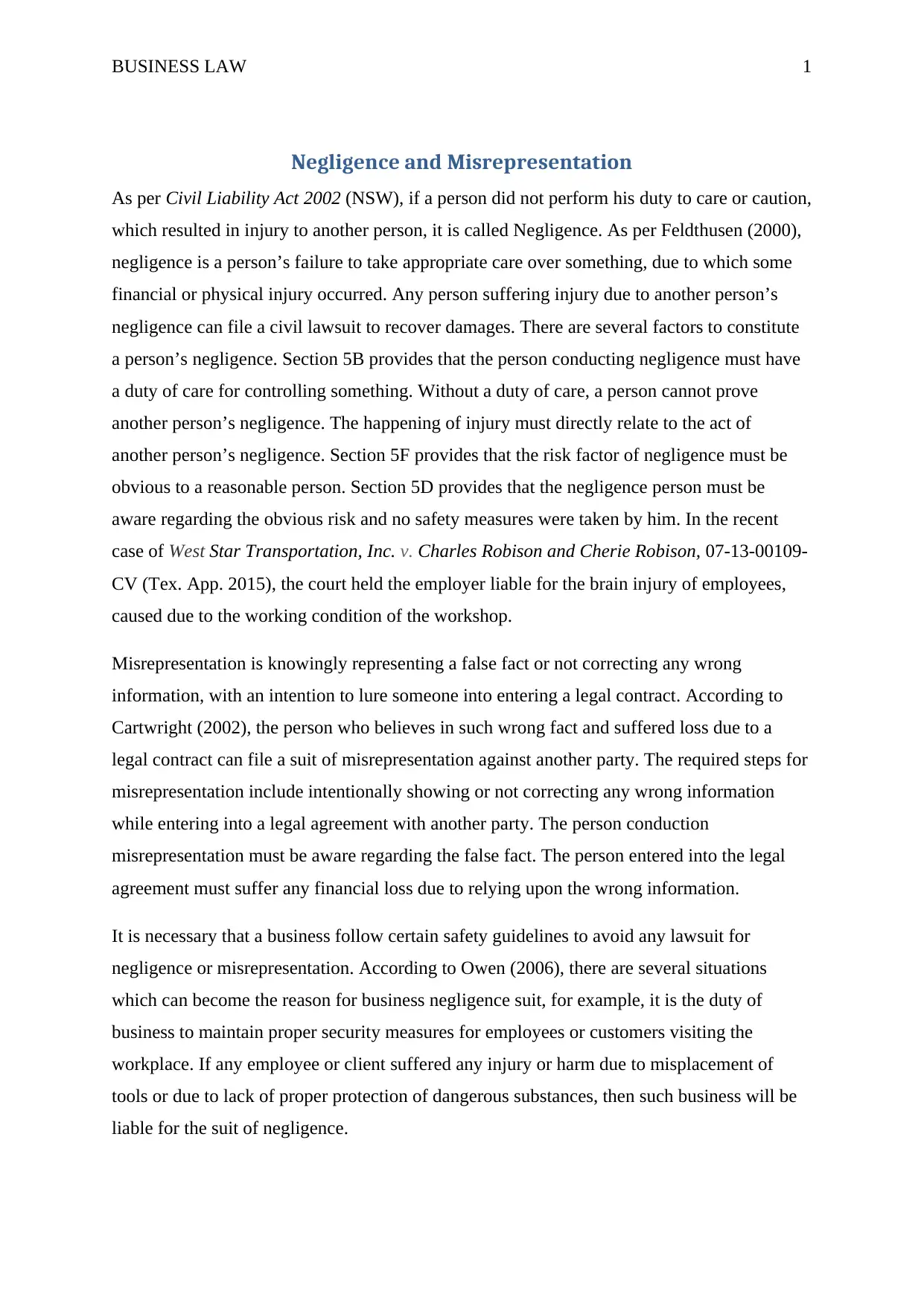
BUSINESS LAW 1
Negligence and Misrepresentation
As per Civil Liability Act 2002 (NSW), if a person did not perform his duty to care or caution,
which resulted in injury to another person, it is called Negligence. As per Feldthusen (2000),
negligence is a person’s failure to take appropriate care over something, due to which some
financial or physical injury occurred. Any person suffering injury due to another person’s
negligence can file a civil lawsuit to recover damages. There are several factors to constitute
a person’s negligence. Section 5B provides that the person conducting negligence must have
a duty of care for controlling something. Without a duty of care, a person cannot prove
another person’s negligence. The happening of injury must directly relate to the act of
another person’s negligence. Section 5F provides that the risk factor of negligence must be
obvious to a reasonable person. Section 5D provides that the negligence person must be
aware regarding the obvious risk and no safety measures were taken by him. In the recent
case of West Star Transportation, Inc. v. Charles Robison and Cherie Robison, 07-13-00109-
CV (Tex. App. 2015), the court held the employer liable for the brain injury of employees,
caused due to the working condition of the workshop.
Misrepresentation is knowingly representing a false fact or not correcting any wrong
information, with an intention to lure someone into entering a legal contract. According to
Cartwright (2002), the person who believes in such wrong fact and suffered loss due to a
legal contract can file a suit of misrepresentation against another party. The required steps for
misrepresentation include intentionally showing or not correcting any wrong information
while entering into a legal agreement with another party. The person conduction
misrepresentation must be aware regarding the false fact. The person entered into the legal
agreement must suffer any financial loss due to relying upon the wrong information.
It is necessary that a business follow certain safety guidelines to avoid any lawsuit for
negligence or misrepresentation. According to Owen (2006), there are several situations
which can become the reason for business negligence suit, for example, it is the duty of
business to maintain proper security measures for employees or customers visiting the
workplace. If any employee or client suffered any injury or harm due to misplacement of
tools or due to lack of proper protection of dangerous substances, then such business will be
liable for the suit of negligence.
Negligence and Misrepresentation
As per Civil Liability Act 2002 (NSW), if a person did not perform his duty to care or caution,
which resulted in injury to another person, it is called Negligence. As per Feldthusen (2000),
negligence is a person’s failure to take appropriate care over something, due to which some
financial or physical injury occurred. Any person suffering injury due to another person’s
negligence can file a civil lawsuit to recover damages. There are several factors to constitute
a person’s negligence. Section 5B provides that the person conducting negligence must have
a duty of care for controlling something. Without a duty of care, a person cannot prove
another person’s negligence. The happening of injury must directly relate to the act of
another person’s negligence. Section 5F provides that the risk factor of negligence must be
obvious to a reasonable person. Section 5D provides that the negligence person must be
aware regarding the obvious risk and no safety measures were taken by him. In the recent
case of West Star Transportation, Inc. v. Charles Robison and Cherie Robison, 07-13-00109-
CV (Tex. App. 2015), the court held the employer liable for the brain injury of employees,
caused due to the working condition of the workshop.
Misrepresentation is knowingly representing a false fact or not correcting any wrong
information, with an intention to lure someone into entering a legal contract. According to
Cartwright (2002), the person who believes in such wrong fact and suffered loss due to a
legal contract can file a suit of misrepresentation against another party. The required steps for
misrepresentation include intentionally showing or not correcting any wrong information
while entering into a legal agreement with another party. The person conduction
misrepresentation must be aware regarding the false fact. The person entered into the legal
agreement must suffer any financial loss due to relying upon the wrong information.
It is necessary that a business follow certain safety guidelines to avoid any lawsuit for
negligence or misrepresentation. According to Owen (2006), there are several situations
which can become the reason for business negligence suit, for example, it is the duty of
business to maintain proper security measures for employees or customers visiting the
workplace. If any employee or client suffered any injury or harm due to misplacement of
tools or due to lack of proper protection of dangerous substances, then such business will be
liable for the suit of negligence.
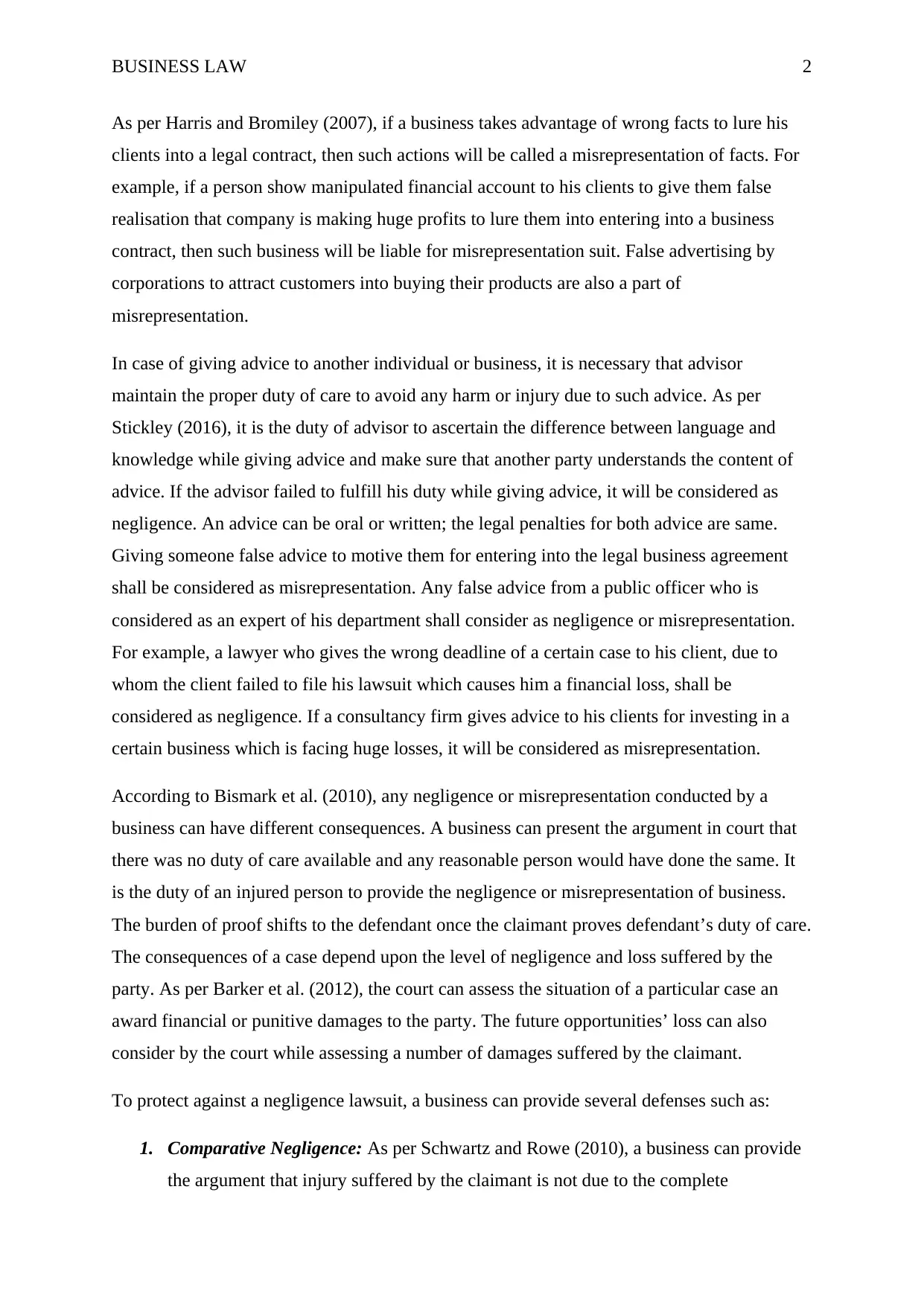
BUSINESS LAW 2
As per Harris and Bromiley (2007), if a business takes advantage of wrong facts to lure his
clients into a legal contract, then such actions will be called a misrepresentation of facts. For
example, if a person show manipulated financial account to his clients to give them false
realisation that company is making huge profits to lure them into entering into a business
contract, then such business will be liable for misrepresentation suit. False advertising by
corporations to attract customers into buying their products are also a part of
misrepresentation.
In case of giving advice to another individual or business, it is necessary that advisor
maintain the proper duty of care to avoid any harm or injury due to such advice. As per
Stickley (2016), it is the duty of advisor to ascertain the difference between language and
knowledge while giving advice and make sure that another party understands the content of
advice. If the advisor failed to fulfill his duty while giving advice, it will be considered as
negligence. An advice can be oral or written; the legal penalties for both advice are same.
Giving someone false advice to motive them for entering into the legal business agreement
shall be considered as misrepresentation. Any false advice from a public officer who is
considered as an expert of his department shall consider as negligence or misrepresentation.
For example, a lawyer who gives the wrong deadline of a certain case to his client, due to
whom the client failed to file his lawsuit which causes him a financial loss, shall be
considered as negligence. If a consultancy firm gives advice to his clients for investing in a
certain business which is facing huge losses, it will be considered as misrepresentation.
According to Bismark et al. (2010), any negligence or misrepresentation conducted by a
business can have different consequences. A business can present the argument in court that
there was no duty of care available and any reasonable person would have done the same. It
is the duty of an injured person to provide the negligence or misrepresentation of business.
The burden of proof shifts to the defendant once the claimant proves defendant’s duty of care.
The consequences of a case depend upon the level of negligence and loss suffered by the
party. As per Barker et al. (2012), the court can assess the situation of a particular case an
award financial or punitive damages to the party. The future opportunities’ loss can also
consider by the court while assessing a number of damages suffered by the claimant.
To protect against a negligence lawsuit, a business can provide several defenses such as:
1. Comparative Negligence: As per Schwartz and Rowe (2010), a business can provide
the argument that injury suffered by the claimant is not due to the complete
As per Harris and Bromiley (2007), if a business takes advantage of wrong facts to lure his
clients into a legal contract, then such actions will be called a misrepresentation of facts. For
example, if a person show manipulated financial account to his clients to give them false
realisation that company is making huge profits to lure them into entering into a business
contract, then such business will be liable for misrepresentation suit. False advertising by
corporations to attract customers into buying their products are also a part of
misrepresentation.
In case of giving advice to another individual or business, it is necessary that advisor
maintain the proper duty of care to avoid any harm or injury due to such advice. As per
Stickley (2016), it is the duty of advisor to ascertain the difference between language and
knowledge while giving advice and make sure that another party understands the content of
advice. If the advisor failed to fulfill his duty while giving advice, it will be considered as
negligence. An advice can be oral or written; the legal penalties for both advice are same.
Giving someone false advice to motive them for entering into the legal business agreement
shall be considered as misrepresentation. Any false advice from a public officer who is
considered as an expert of his department shall consider as negligence or misrepresentation.
For example, a lawyer who gives the wrong deadline of a certain case to his client, due to
whom the client failed to file his lawsuit which causes him a financial loss, shall be
considered as negligence. If a consultancy firm gives advice to his clients for investing in a
certain business which is facing huge losses, it will be considered as misrepresentation.
According to Bismark et al. (2010), any negligence or misrepresentation conducted by a
business can have different consequences. A business can present the argument in court that
there was no duty of care available and any reasonable person would have done the same. It
is the duty of an injured person to provide the negligence or misrepresentation of business.
The burden of proof shifts to the defendant once the claimant proves defendant’s duty of care.
The consequences of a case depend upon the level of negligence and loss suffered by the
party. As per Barker et al. (2012), the court can assess the situation of a particular case an
award financial or punitive damages to the party. The future opportunities’ loss can also
consider by the court while assessing a number of damages suffered by the claimant.
To protect against a negligence lawsuit, a business can provide several defenses such as:
1. Comparative Negligence: As per Schwartz and Rowe (2010), a business can provide
the argument that injury suffered by the claimant is not due to the complete
⊘ This is a preview!⊘
Do you want full access?
Subscribe today to unlock all pages.

Trusted by 1+ million students worldwide
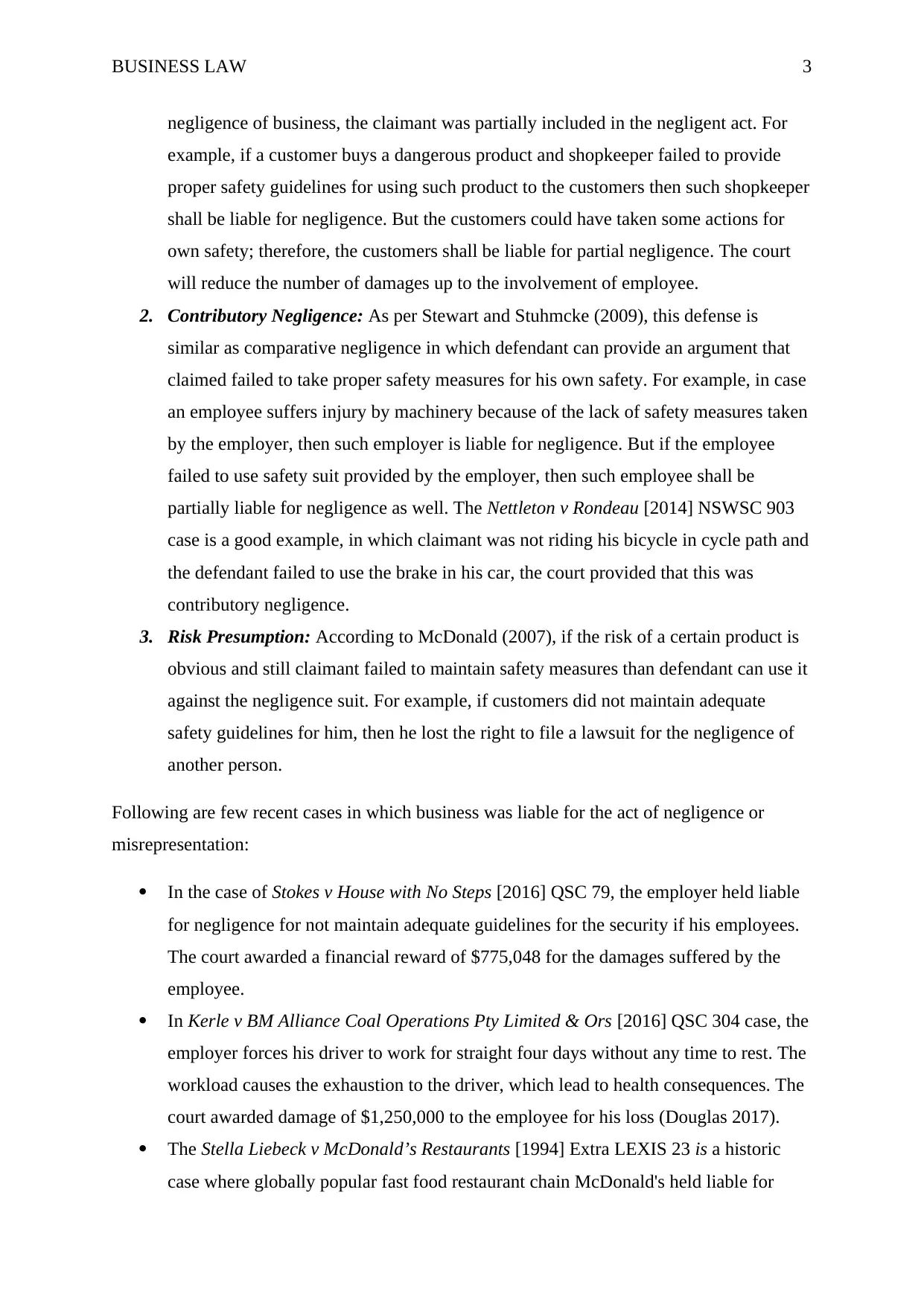
BUSINESS LAW 3
negligence of business, the claimant was partially included in the negligent act. For
example, if a customer buys a dangerous product and shopkeeper failed to provide
proper safety guidelines for using such product to the customers then such shopkeeper
shall be liable for negligence. But the customers could have taken some actions for
own safety; therefore, the customers shall be liable for partial negligence. The court
will reduce the number of damages up to the involvement of employee.
2. Contributory Negligence: As per Stewart and Stuhmcke (2009), this defense is
similar as comparative negligence in which defendant can provide an argument that
claimed failed to take proper safety measures for his own safety. For example, in case
an employee suffers injury by machinery because of the lack of safety measures taken
by the employer, then such employer is liable for negligence. But if the employee
failed to use safety suit provided by the employer, then such employee shall be
partially liable for negligence as well. The Nettleton v Rondeau [2014] NSWSC 903
case is a good example, in which claimant was not riding his bicycle in cycle path and
the defendant failed to use the brake in his car, the court provided that this was
contributory negligence.
3. Risk Presumption: According to McDonald (2007), if the risk of a certain product is
obvious and still claimant failed to maintain safety measures than defendant can use it
against the negligence suit. For example, if customers did not maintain adequate
safety guidelines for him, then he lost the right to file a lawsuit for the negligence of
another person.
Following are few recent cases in which business was liable for the act of negligence or
misrepresentation:
In the case of Stokes v House with No Steps [2016] QSC 79, the employer held liable
for negligence for not maintain adequate guidelines for the security if his employees.
The court awarded a financial reward of $775,048 for the damages suffered by the
employee.
In Kerle v BM Alliance Coal Operations Pty Limited & Ors [2016] QSC 304 case, the
employer forces his driver to work for straight four days without any time to rest. The
workload causes the exhaustion to the driver, which lead to health consequences. The
court awarded damage of $1,250,000 to the employee for his loss (Douglas 2017).
The Stella Liebeck v McDonald’s Restaurants [1994] Extra LEXIS 23 is a historic
case where globally popular fast food restaurant chain McDonald's held liable for
negligence of business, the claimant was partially included in the negligent act. For
example, if a customer buys a dangerous product and shopkeeper failed to provide
proper safety guidelines for using such product to the customers then such shopkeeper
shall be liable for negligence. But the customers could have taken some actions for
own safety; therefore, the customers shall be liable for partial negligence. The court
will reduce the number of damages up to the involvement of employee.
2. Contributory Negligence: As per Stewart and Stuhmcke (2009), this defense is
similar as comparative negligence in which defendant can provide an argument that
claimed failed to take proper safety measures for his own safety. For example, in case
an employee suffers injury by machinery because of the lack of safety measures taken
by the employer, then such employer is liable for negligence. But if the employee
failed to use safety suit provided by the employer, then such employee shall be
partially liable for negligence as well. The Nettleton v Rondeau [2014] NSWSC 903
case is a good example, in which claimant was not riding his bicycle in cycle path and
the defendant failed to use the brake in his car, the court provided that this was
contributory negligence.
3. Risk Presumption: According to McDonald (2007), if the risk of a certain product is
obvious and still claimant failed to maintain safety measures than defendant can use it
against the negligence suit. For example, if customers did not maintain adequate
safety guidelines for him, then he lost the right to file a lawsuit for the negligence of
another person.
Following are few recent cases in which business was liable for the act of negligence or
misrepresentation:
In the case of Stokes v House with No Steps [2016] QSC 79, the employer held liable
for negligence for not maintain adequate guidelines for the security if his employees.
The court awarded a financial reward of $775,048 for the damages suffered by the
employee.
In Kerle v BM Alliance Coal Operations Pty Limited & Ors [2016] QSC 304 case, the
employer forces his driver to work for straight four days without any time to rest. The
workload causes the exhaustion to the driver, which lead to health consequences. The
court awarded damage of $1,250,000 to the employee for his loss (Douglas 2017).
The Stella Liebeck v McDonald’s Restaurants [1994] Extra LEXIS 23 is a historic
case where globally popular fast food restaurant chain McDonald's held liable for
Paraphrase This Document
Need a fresh take? Get an instant paraphrase of this document with our AI Paraphraser
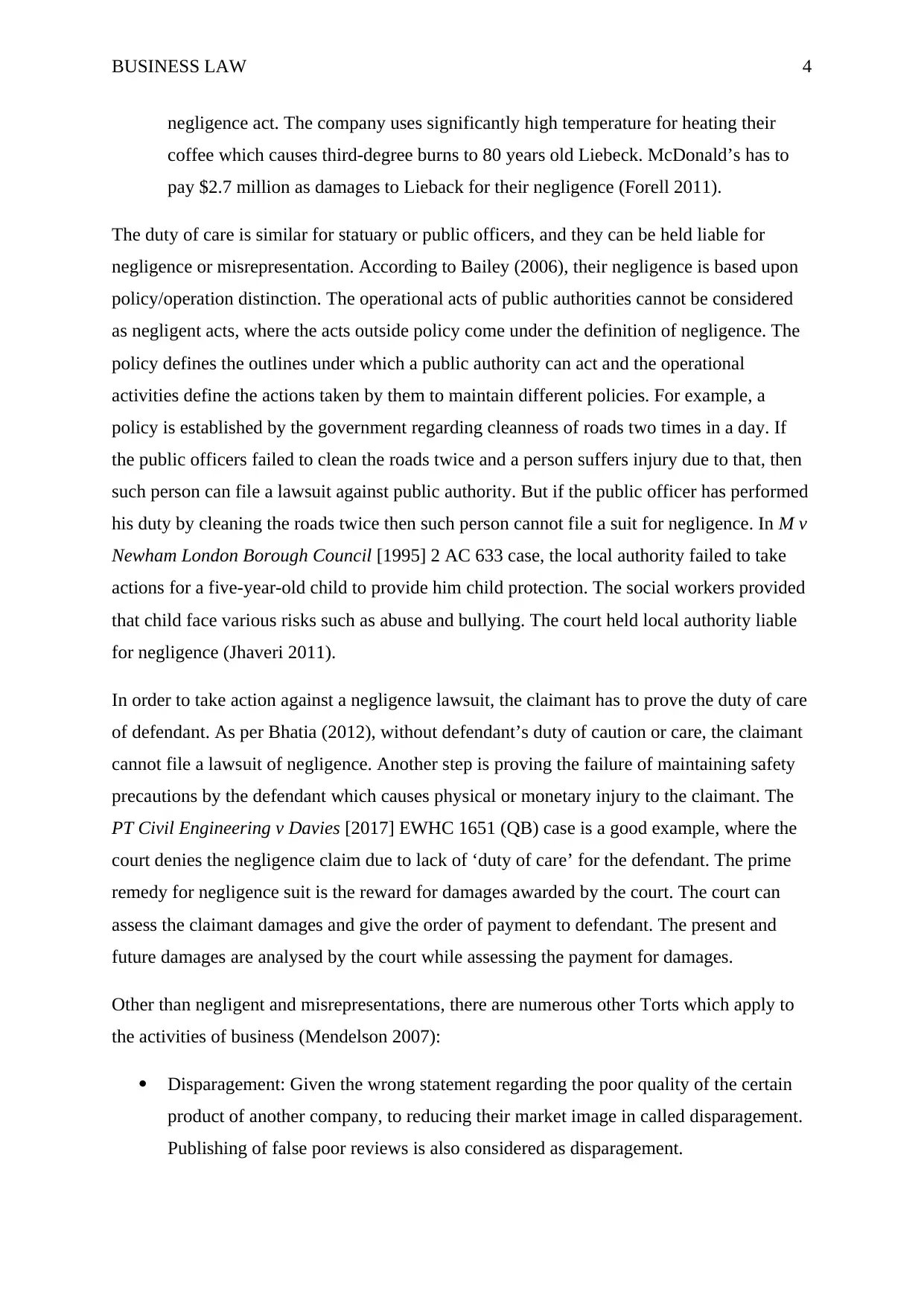
BUSINESS LAW 4
negligence act. The company uses significantly high temperature for heating their
coffee which causes third-degree burns to 80 years old Liebeck. McDonald’s has to
pay $2.7 million as damages to Lieback for their negligence (Forell 2011).
The duty of care is similar for statuary or public officers, and they can be held liable for
negligence or misrepresentation. According to Bailey (2006), their negligence is based upon
policy/operation distinction. The operational acts of public authorities cannot be considered
as negligent acts, where the acts outside policy come under the definition of negligence. The
policy defines the outlines under which a public authority can act and the operational
activities define the actions taken by them to maintain different policies. For example, a
policy is established by the government regarding cleanness of roads two times in a day. If
the public officers failed to clean the roads twice and a person suffers injury due to that, then
such person can file a lawsuit against public authority. But if the public officer has performed
his duty by cleaning the roads twice then such person cannot file a suit for negligence. In M v
Newham London Borough Council [1995] 2 AC 633 case, the local authority failed to take
actions for a five-year-old child to provide him child protection. The social workers provided
that child face various risks such as abuse and bullying. The court held local authority liable
for negligence (Jhaveri 2011).
In order to take action against a negligence lawsuit, the claimant has to prove the duty of care
of defendant. As per Bhatia (2012), without defendant’s duty of caution or care, the claimant
cannot file a lawsuit of negligence. Another step is proving the failure of maintaining safety
precautions by the defendant which causes physical or monetary injury to the claimant. The
PT Civil Engineering v Davies [2017] EWHC 1651 (QB) case is a good example, where the
court denies the negligence claim due to lack of ‘duty of care’ for the defendant. The prime
remedy for negligence suit is the reward for damages awarded by the court. The court can
assess the claimant damages and give the order of payment to defendant. The present and
future damages are analysed by the court while assessing the payment for damages.
Other than negligent and misrepresentations, there are numerous other Torts which apply to
the activities of business (Mendelson 2007):
Disparagement: Given the wrong statement regarding the poor quality of the certain
product of another company, to reducing their market image in called disparagement.
Publishing of false poor reviews is also considered as disparagement.
negligence act. The company uses significantly high temperature for heating their
coffee which causes third-degree burns to 80 years old Liebeck. McDonald’s has to
pay $2.7 million as damages to Lieback for their negligence (Forell 2011).
The duty of care is similar for statuary or public officers, and they can be held liable for
negligence or misrepresentation. According to Bailey (2006), their negligence is based upon
policy/operation distinction. The operational acts of public authorities cannot be considered
as negligent acts, where the acts outside policy come under the definition of negligence. The
policy defines the outlines under which a public authority can act and the operational
activities define the actions taken by them to maintain different policies. For example, a
policy is established by the government regarding cleanness of roads two times in a day. If
the public officers failed to clean the roads twice and a person suffers injury due to that, then
such person can file a lawsuit against public authority. But if the public officer has performed
his duty by cleaning the roads twice then such person cannot file a suit for negligence. In M v
Newham London Borough Council [1995] 2 AC 633 case, the local authority failed to take
actions for a five-year-old child to provide him child protection. The social workers provided
that child face various risks such as abuse and bullying. The court held local authority liable
for negligence (Jhaveri 2011).
In order to take action against a negligence lawsuit, the claimant has to prove the duty of care
of defendant. As per Bhatia (2012), without defendant’s duty of caution or care, the claimant
cannot file a lawsuit of negligence. Another step is proving the failure of maintaining safety
precautions by the defendant which causes physical or monetary injury to the claimant. The
PT Civil Engineering v Davies [2017] EWHC 1651 (QB) case is a good example, where the
court denies the negligence claim due to lack of ‘duty of care’ for the defendant. The prime
remedy for negligence suit is the reward for damages awarded by the court. The court can
assess the claimant damages and give the order of payment to defendant. The present and
future damages are analysed by the court while assessing the payment for damages.
Other than negligent and misrepresentations, there are numerous other Torts which apply to
the activities of business (Mendelson 2007):
Disparagement: Given the wrong statement regarding the poor quality of the certain
product of another company, to reducing their market image in called disparagement.
Publishing of false poor reviews is also considered as disparagement.
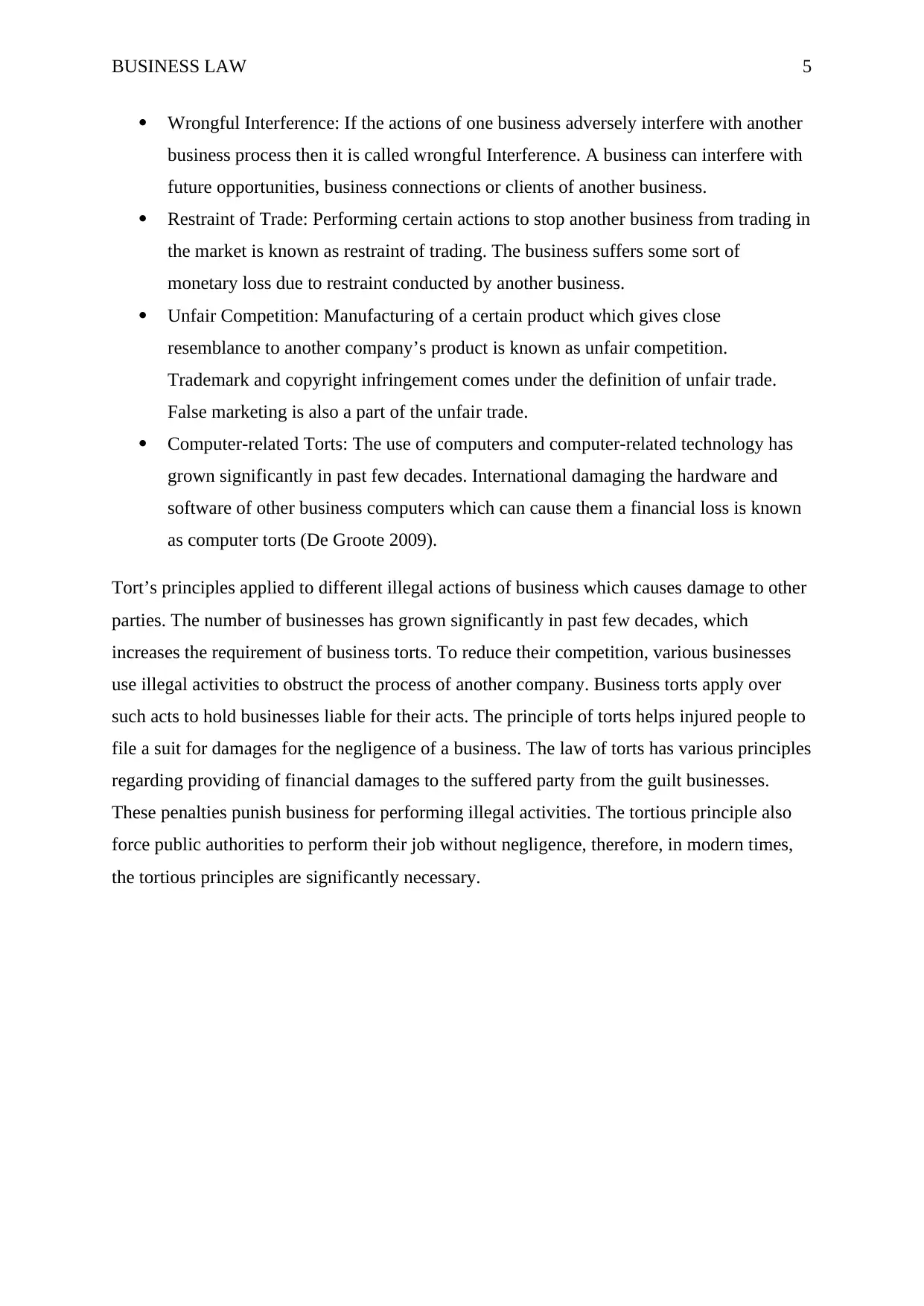
BUSINESS LAW 5
Wrongful Interference: If the actions of one business adversely interfere with another
business process then it is called wrongful Interference. A business can interfere with
future opportunities, business connections or clients of another business.
Restraint of Trade: Performing certain actions to stop another business from trading in
the market is known as restraint of trading. The business suffers some sort of
monetary loss due to restraint conducted by another business.
Unfair Competition: Manufacturing of a certain product which gives close
resemblance to another company’s product is known as unfair competition.
Trademark and copyright infringement comes under the definition of unfair trade.
False marketing is also a part of the unfair trade.
Computer-related Torts: The use of computers and computer-related technology has
grown significantly in past few decades. International damaging the hardware and
software of other business computers which can cause them a financial loss is known
as computer torts (De Groote 2009).
Tort’s principles applied to different illegal actions of business which causes damage to other
parties. The number of businesses has grown significantly in past few decades, which
increases the requirement of business torts. To reduce their competition, various businesses
use illegal activities to obstruct the process of another company. Business torts apply over
such acts to hold businesses liable for their acts. The principle of torts helps injured people to
file a suit for damages for the negligence of a business. The law of torts has various principles
regarding providing of financial damages to the suffered party from the guilt businesses.
These penalties punish business for performing illegal activities. The tortious principle also
force public authorities to perform their job without negligence, therefore, in modern times,
the tortious principles are significantly necessary.
Wrongful Interference: If the actions of one business adversely interfere with another
business process then it is called wrongful Interference. A business can interfere with
future opportunities, business connections or clients of another business.
Restraint of Trade: Performing certain actions to stop another business from trading in
the market is known as restraint of trading. The business suffers some sort of
monetary loss due to restraint conducted by another business.
Unfair Competition: Manufacturing of a certain product which gives close
resemblance to another company’s product is known as unfair competition.
Trademark and copyright infringement comes under the definition of unfair trade.
False marketing is also a part of the unfair trade.
Computer-related Torts: The use of computers and computer-related technology has
grown significantly in past few decades. International damaging the hardware and
software of other business computers which can cause them a financial loss is known
as computer torts (De Groote 2009).
Tort’s principles applied to different illegal actions of business which causes damage to other
parties. The number of businesses has grown significantly in past few decades, which
increases the requirement of business torts. To reduce their competition, various businesses
use illegal activities to obstruct the process of another company. Business torts apply over
such acts to hold businesses liable for their acts. The principle of torts helps injured people to
file a suit for damages for the negligence of a business. The law of torts has various principles
regarding providing of financial damages to the suffered party from the guilt businesses.
These penalties punish business for performing illegal activities. The tortious principle also
force public authorities to perform their job without negligence, therefore, in modern times,
the tortious principles are significantly necessary.
⊘ This is a preview!⊘
Do you want full access?
Subscribe today to unlock all pages.

Trusted by 1+ million students worldwide
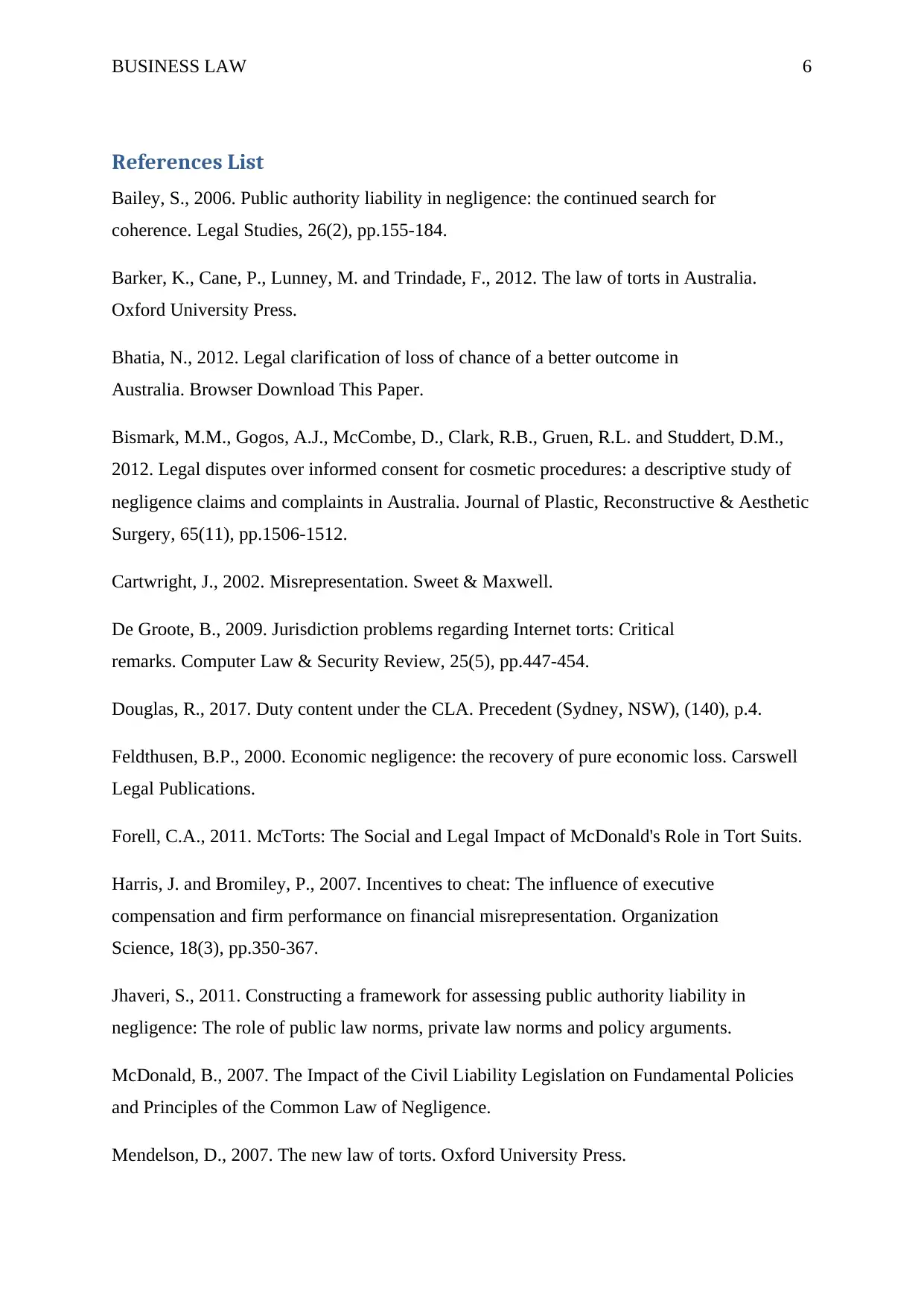
BUSINESS LAW 6
References List
Bailey, S., 2006. Public authority liability in negligence: the continued search for
coherence. Legal Studies, 26(2), pp.155-184.
Barker, K., Cane, P., Lunney, M. and Trindade, F., 2012. The law of torts in Australia.
Oxford University Press.
Bhatia, N., 2012. Legal clarification of loss of chance of a better outcome in
Australia. Browser Download This Paper.
Bismark, M.M., Gogos, A.J., McCombe, D., Clark, R.B., Gruen, R.L. and Studdert, D.M.,
2012. Legal disputes over informed consent for cosmetic procedures: a descriptive study of
negligence claims and complaints in Australia. Journal of Plastic, Reconstructive & Aesthetic
Surgery, 65(11), pp.1506-1512.
Cartwright, J., 2002. Misrepresentation. Sweet & Maxwell.
De Groote, B., 2009. Jurisdiction problems regarding Internet torts: Critical
remarks. Computer Law & Security Review, 25(5), pp.447-454.
Douglas, R., 2017. Duty content under the CLA. Precedent (Sydney, NSW), (140), p.4.
Feldthusen, B.P., 2000. Economic negligence: the recovery of pure economic loss. Carswell
Legal Publications.
Forell, C.A., 2011. McTorts: The Social and Legal Impact of McDonald's Role in Tort Suits.
Harris, J. and Bromiley, P., 2007. Incentives to cheat: The influence of executive
compensation and firm performance on financial misrepresentation. Organization
Science, 18(3), pp.350-367.
Jhaveri, S., 2011. Constructing a framework for assessing public authority liability in
negligence: The role of public law norms, private law norms and policy arguments.
McDonald, B., 2007. The Impact of the Civil Liability Legislation on Fundamental Policies
and Principles of the Common Law of Negligence.
Mendelson, D., 2007. The new law of torts. Oxford University Press.
References List
Bailey, S., 2006. Public authority liability in negligence: the continued search for
coherence. Legal Studies, 26(2), pp.155-184.
Barker, K., Cane, P., Lunney, M. and Trindade, F., 2012. The law of torts in Australia.
Oxford University Press.
Bhatia, N., 2012. Legal clarification of loss of chance of a better outcome in
Australia. Browser Download This Paper.
Bismark, M.M., Gogos, A.J., McCombe, D., Clark, R.B., Gruen, R.L. and Studdert, D.M.,
2012. Legal disputes over informed consent for cosmetic procedures: a descriptive study of
negligence claims and complaints in Australia. Journal of Plastic, Reconstructive & Aesthetic
Surgery, 65(11), pp.1506-1512.
Cartwright, J., 2002. Misrepresentation. Sweet & Maxwell.
De Groote, B., 2009. Jurisdiction problems regarding Internet torts: Critical
remarks. Computer Law & Security Review, 25(5), pp.447-454.
Douglas, R., 2017. Duty content under the CLA. Precedent (Sydney, NSW), (140), p.4.
Feldthusen, B.P., 2000. Economic negligence: the recovery of pure economic loss. Carswell
Legal Publications.
Forell, C.A., 2011. McTorts: The Social and Legal Impact of McDonald's Role in Tort Suits.
Harris, J. and Bromiley, P., 2007. Incentives to cheat: The influence of executive
compensation and firm performance on financial misrepresentation. Organization
Science, 18(3), pp.350-367.
Jhaveri, S., 2011. Constructing a framework for assessing public authority liability in
negligence: The role of public law norms, private law norms and policy arguments.
McDonald, B., 2007. The Impact of the Civil Liability Legislation on Fundamental Policies
and Principles of the Common Law of Negligence.
Mendelson, D., 2007. The new law of torts. Oxford University Press.
Paraphrase This Document
Need a fresh take? Get an instant paraphrase of this document with our AI Paraphraser
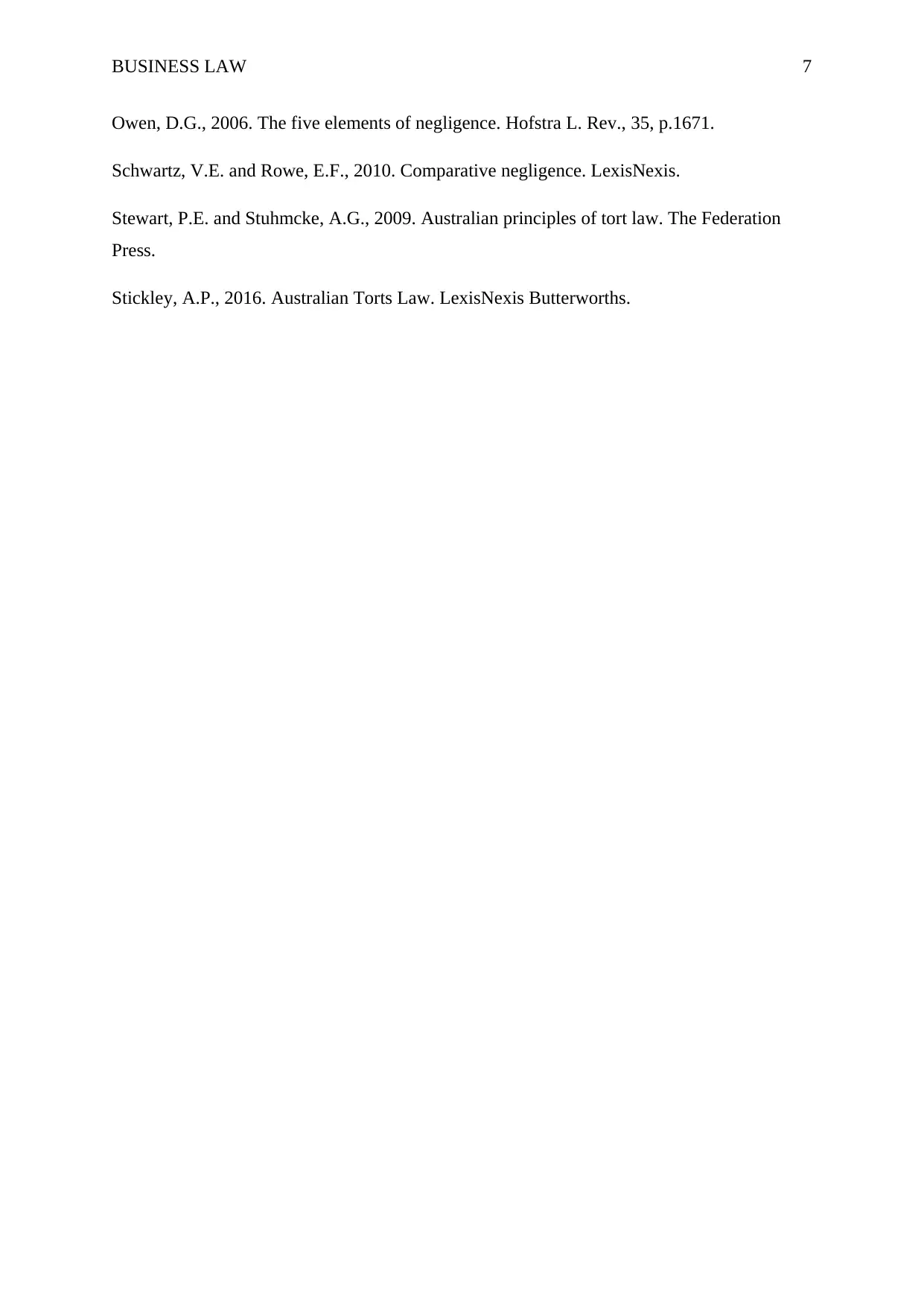
BUSINESS LAW 7
Owen, D.G., 2006. The five elements of negligence. Hofstra L. Rev., 35, p.1671.
Schwartz, V.E. and Rowe, E.F., 2010. Comparative negligence. LexisNexis.
Stewart, P.E. and Stuhmcke, A.G., 2009. Australian principles of tort law. The Federation
Press.
Stickley, A.P., 2016. Australian Torts Law. LexisNexis Butterworths.
Owen, D.G., 2006. The five elements of negligence. Hofstra L. Rev., 35, p.1671.
Schwartz, V.E. and Rowe, E.F., 2010. Comparative negligence. LexisNexis.
Stewart, P.E. and Stuhmcke, A.G., 2009. Australian principles of tort law. The Federation
Press.
Stickley, A.P., 2016. Australian Torts Law. LexisNexis Butterworths.
1 out of 8
Related Documents
Your All-in-One AI-Powered Toolkit for Academic Success.
+13062052269
info@desklib.com
Available 24*7 on WhatsApp / Email
![[object Object]](/_next/static/media/star-bottom.7253800d.svg)
Unlock your academic potential
Copyright © 2020–2025 A2Z Services. All Rights Reserved. Developed and managed by ZUCOL.





